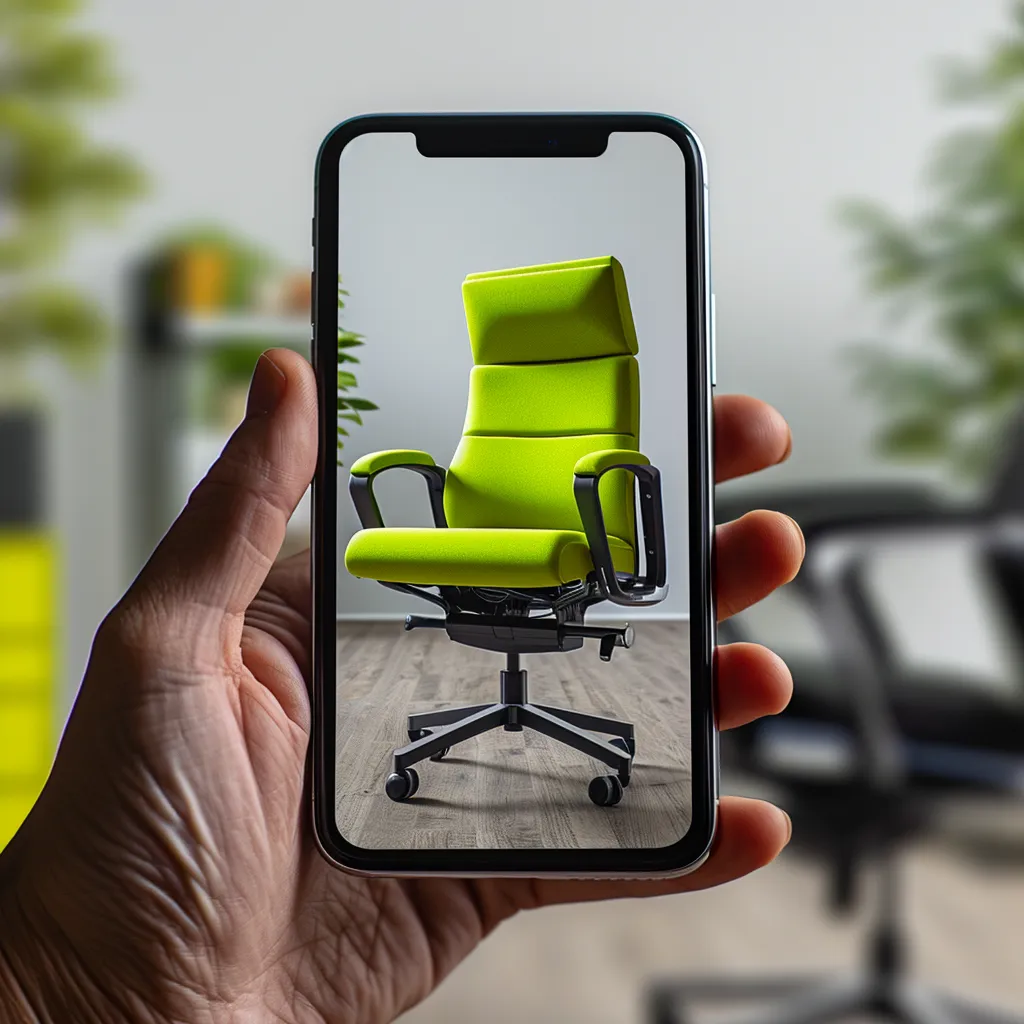Use Our Free Learning Resources to Free Yourself from Growth Killing Shackles

How Can Augmented Reality Apps Provide More Interactive Shopping Experiences?
In the rapidly evolving world of e-commerce, augmented reality apps for providing more interactive shopping experiences have emerged as a game-changer. These innovative apps are transforming the way consumers engage with products, making the online shopping journey more immersive and personalized than ever before.
As a business owner, you know how tough it is to stand out in the digital crowd. That's where augmented reality technology comes in - integrate it into your mobile app and watch customer satisfaction soar, driving sales and giving you a serious competitive edge.
Imagine walking into a virtual store, surrounded by virtual shelves stocked with products that come to life before your eyes. Sounds like science fiction, right? Not with augmented reality apps for providing more interactive shopping experiences! But with the crowded AR landscape, it's tough to stand out. So, what sets the top augmented reality apps apart, and how can you develop an AR strategy that speaks to your target audience?
Top 5 Augmented Reality Apps for Providing More Interactive Shopping Experiences
To truly connect with customers, you need to speak their language. AR apps are speaking theirs, offering immersive experiences that engage shoppers on a deeper level. With virtual try-ons and personalized advice, customers are no longer just browsing – they're fully immersed in the brand.
(Your) shopping just got a whole lot cooler. Here are the top augmented reality apps that are bringing a fresh spin to the shopping experience.
1. Virtual Try-On Apps for Fashion and Accessories
Virtual try-on apps let you see how clothes and accessories look on you before buying. Using your phone's camera, these AR apps overlay digital images of products onto your live feed, creating an immersive experience that's like having a virtual fitting room in your pocket.
Ready to transform your online shopping experience? With cutting-edge apps like L'Oreal's Style My Hair and Warby Parker's Virtual Try-On, customers can effortlessly explore different styles and discover their ideal look, streamlining the online shopping process.

2. AR Furniture Placement Apps for Home Decor
Furniture placement apps use AR technology to help you visualize how furniture will look in your space. Just point your phone's camera at the room and these apps will superimpose 3D models of furniture, allowing customers to see how items fit in terms of size, style, and color.
Imagine walking into your dream home, surrounded by furniture that's tailored to your unique style. IKEA Place and Wayfair View make that possible, giving you the power to visualize and test different layouts – it's an immersive experience that feels surreal.
3. AR Product Visualization Apps for Electronics and Gadgets
Immerse yourself in the world of electronic devices with AR-powered product visualization apps. You'll feel like you're holding the device in your hands, rotating it to examine every detail, and even simulating its use with incredible accuracy.
Imagine being able to explore tech products in 3D before making a purchase. Thanks to Apple's AR Quick Look and Amazon's AR View, customers can do just that. This immersive shopping experience arms them with the knowledge they need to make smarter buying decisions.
4. AR Beauty and Cosmetics Apps for Personalized Recommendations
Looking for the perfect beauty products? Cosmetic apps have got you covered. By analyzing your facial features, skin tone, and preferences, these apps provide personalized product recommendations that are spot on. And to take it to the next level, you can even virtually try on makeup, haircare, and skincare products for an immersive experience that's as real as it gets.
Ever wondered how AR is changing the shopping game? Research suggests that it boosts both enjoyment and perceived informative value. Just look at apps like YouCam Makeup, where customers can explore products in a whole new way, making more confident buying decisions.
5. AR Car Customization Apps for Automotive Enthusiasts
Ever wondered what your car would look like with a bold new paint job or sleek wheels? Car customization apps using AR technology can show you exactly that. Simply upload a photo of your ride, and these apps will let you try on different styles and accessories - allowing customers to try before they buy and see the result in high-definition.
Imagine being able to envision your dream car down to the last detail. That's what innovative tools like RelayCars and CarLens offer – an immersive experience that lets customers design their ideal ride with confidence.
How Augmented Reality Enhances the Customer Shopping Journey
Imagine being able to virtually try on clothes or see how furniture would look in your home before making a purchase. Augmented reality is making this a reality, and it's transforming the customer shopping journey in the process.
Pre-Purchase: Product Visualization and Virtual Try-On
Before clicking "buy," customers often wonder how a product will fit or look in their space. Virtual try-on capabilities, made possible by AR, provide the answer. By letting customers visualize products in their own environment, we can eliminate uncertainty and enhance the overall shopping experience.
The numbers are clear: interactive AR experiences drive sales and reduce returns. That's because when shoppers can virtually try before they buy, they're more confident in their choices, leading to a better online shopping experience overall.
Point of Purchase: Seamless and Engaging Checkout
Rethink the traditional checkout process with AR, which cleverly weaves in snippets of product details and customized suggestions to keep customers invested every step of the way.
Take your customers on a thrilling ride to the checkout. By boosting the final purchasing step, you'll likely see a surge in average order values and a decline in cart abandonment rates.
Post-Purchase: Customer Support and Loyalty Programs
What happens after you buy a product? With AR, the experience just gets better. Customers get to enjoy super-helpful, interactive support, plus step-by-step guides to fix common problems – all thanks to AR. Result? Fewer calls to customer support.
Better than a simple rewards card, AR-based loyalty programs engage customers in a way that feels fresh and exciting. Virtual scavenger hunts, exclusive content – it's all about crafting an experience that resonates with customers and inspires brand loyalty.
The Benefits of Integrating AR Technology into Retail Apps
Take your retail app to the next level by embracing augmented reality technology. This innovative fusion can revolutionize customer engagement, fortify brand loyalty, and provide a goldmine of actionable insights. The benefits are clear: get ready to elevate your brand.
Increased Customer Engagement and Satisfaction
Imagine strolling through a virtual store, where products spring to life, offering personalized interactions. Retail apps with AR features make this possible, lifting the shopping experience to new heights and producing higher customer satisfaction.
This kind of customer engagement is like a positive feedback loop, where happy customers become brand ambassadors, driving sales and attracting new faces to your store.

Improved Brand Loyalty and Repeat Purchases
Retailers that push the boundaries of AR create experiences that resonate deeply with customers. This is where the magic happens – customers form lasting bonds with the brand, driving loyalty and encouraging repeat business.
A seamless AR experience equals customer satisfaction, which quickly turns into brand loyalty. Retailers that ace this personalized approach can effortlessly turn new customers into long-term advocates.
Valuable Data Insights for Personalized Marketing
With AR interactions, retailers can tap into the mind of their customers like never before. They get to see, in real-time, how shoppers interact with products, exposing latent preferences, behaviors, and purchase drivers. This powerful data can be channeled into creating highly targeted marketing campaigns and personalized recommendations that hit the bullseye.
What if you could seriously upgrade your customers' shopping experience and, as a result, watch your sales soar? That's exactly what happens when you tap into the insights offered by AR data.
Real-World Examples of Successful AR Shopping Apps
Imagine trying on clothes virtually or seeing how furniture would look in your home before making a purchase. Augmented reality shopping apps are making this a reality, and we're about to explore some standout examples that are revolutionizing retail.
Sephora's Virtual Artist App for Beauty Products
Sephora's Virtual Artist app is a prime example of a successful AR shopping app in the beauty industry. The app allows users to virtually try on makeup products using their smartphone camera, providing a realistic and personalized experience. Users can experiment with different shades, styles, and looks without the need to physically apply the products.
Virtually try before you buy? Sephora's got it down. Their Virtual Artist app makes it a breeze to find the perfect product, and customers love it. As a result, sales are soaring and brand loyalty is stronger than ever – all thanks to a superior customer experience powered by innovative AR tech.
IKEA Place App for Furniture Visualization
With IKEA Place, shopping for furniture just got a whole lot easier. This innovative AR app lets you bring IKEA products into your home, virtually. Simply point your smartphone camera at the space, and you can preview how that sleek sofa or stylish chair would look in your living room.
Furniture fit got you stressed? IKEA Place has got your back. By providing precise measurements and scaling, this app ensures that your new furniture will fit seamlessly into its new home, giving you peace of mind and reducing the likelihood of returns.
Warby Parker's Virtual Try-On App for Eyewear
In a bold move, Warby Parker has cracked the code on virtual eyewear shopping with their Virtual Try-On app. Using AR technology, customers can see themselves in different frames without ever having to physically put them on – talk about a shopping experience upgrade.
In a world where one-size-fits-all simply doesn't cut it, Warby Parker's Virtual Try-On app shines with its super-personalized recommendations. Based on your face shape, favorite hues, and style DNA, the app serves up glasses and sunglasses that are spot-on. And the benefits? A more engaged customer base, fewer in-store visits, and a tidy increase in online sales.
Imagine shopping without ever having to leave your home - or even getting dressed. Augmented reality apps from retailers like Sephora, IKEA, and Warby Parker are making that a reality. With interactive experiences that blend the physical and digital, these brands are reimagining the retail landscape.
Overcoming Challenges in Implementing AR Shopping Experiences
The marriage of augmented reality and shopping promises a future where the physical and digital blend seamlessly. However, this futuristic vision is hindered by the practical realities of implementation. By acknowledging these hurdles, retailers can forge ahead, crafting experiences that meld fantasy and reality, driving customer engagement and loyalty.
Technical Limitations and Compatibility Issues
AR shopping experiences are only as good as the tech behind them. Sadly, that tech is often hindered by limitations and compatibility woes. Powerful hardware and software are must-haves for AR, but not all devices can keep up. And when you add different operating systems and AR platforms to the mix, it's a miracle we get a smooth experience at all.
What's holding retailers back from creating amazing AR experiences? It's the technical details, of course. But with the right AR experts on board, they can iron out these kinks and design apps that effortlessly run on a variety of devices, ultimately broadening their AR reach.
User Adoption and Education
Adopting AR shopping experiences can be a hurdle for customers. With AR technology still in its relative infancy, many users are unsure how to leverage its capabilities within retail apps. Retailers must take the initiative to educate their customers, providing accessible guidance and intuitive tutorials that empower users to harness the full potential of AR.
AR adoption hinges on one crucial factor: user experience. Retailers must prioritize designing intuitive AR apps that users can pick up quickly, sans hassle or confusion. The payoff? Increased engagement and a loyal customer base.
Balancing AR Features with User Experience
Retailers should exercise restraint when injecting AR into their shopping experience. Overzealous feature-packing can cripple performance, sap batteries, and test users' patience. A more effective approach involves thoughtfully selecting AR tools that deliver tangible benefits and then neatly incorporating them into the app's interface.
Regular user testing and feedback loops can help retailers optimize the balance between AR features and overall user experience. By carefully selecting and integrating AR features, retailers can create immersive experiences that enhance the customer experience without compromising usability.
By addressing these challenges head-on, retailers can create immersive experiences that engage customers, drive satisfaction, and ultimately lead to increased sales and brand loyalty.
The Future of Augmented Reality in E-commerce and Retail
The reality app revolution is well underway, and its impact on shopping is just the beginning. As AR continues to evolve, we're on the cusp of a seismic shift in the way we shop.
Integration with AI and Machine Learning for Personalized Recommendations
The future of AR in e-commerce and retail lies in its integration with artificial intelligence (AI) and machine learning technologies. By combining AR with AI and machine learning, retailers can offer highly personalized product recommendations based on a customer's preferences, past purchases, and real-time interactions with AR features.
For example, an AR beauty app could analyze a customer's skin tone, facial features, and virtual try-on data to recommend products that are tailored to their specific needs and style preferences. This level of personalization can greatly enhance the online shopping experience and drive customer loyalty.
Expansion to Social Media Platforms and Influencer Marketing
Another future trend for AR in e-commerce and retail is its expansion to social media platforms and influencer marketing. As social media platforms like Instagram and Snapchat continue to invest in AR features, retailers have the opportunity to create AR-powered social media campaigns and collaborations with influencers.
For example, a fashion brand could partner with a popular Instagram influencer to create an AR filter that allows users to virtually try on the brand's latest collection. This type of AR-driven influencer marketing can increase brand exposure, drive user-generated content, and attract new customers to the brand's e-commerce platform.
Potential for AR-Driven Omnichannel Experiences
The future of AR in e-commerce and retail also holds the potential for creating seamless omnichannel experiences. By integrating AR technology across online and offline channels, retailers can provide customers with a consistent and engaging shopping journey.
For example, a customer could use an AR app to virtually try on a product at home, then visit a physical store to see the product in person and complete the purchase. The store could have AR-enabled displays that provide additional product information and personalized recommendations based on the customer's online interactions.
This type of AR-driven omnichannel experience can bridge the gap between online and offline shopping, providing customers with the best of both worlds. As these trends continue to shape the future of augmented reality shopping apps, retailers who embrace AR technology will be well-positioned to offer immersive experiences that engage customers, drive sales, and foster long-lasting brand loyalty.
FAQs in Relation to Augmented Reality Apps for Providing More Interactive Shopping Experiences
How is augmented reality used in shopping?
Augmented reality is like a magic mirror that brings products to life. It's used to create immersive experiences, letting customers "try before they buy" virtually. AR apps help people visualize products in their space, like furniture in a living room, or see how makeup looks on their face, making shopping more engaging and personal.
How could AR be used to enhance the customer shopping experience?
Imagine having a personal shopping assistant at your fingertips. AR can guide customers through product demos, offer styling tips, and provide extra product details. It's like having a store expert at your beck and call, without the need for physical stores. This leads to increased customer satisfaction and loyalty.
Can augmented reality be interactive?
'Hanging out' with products has a whole new meaning with AR. Users can interactive with products in 3D, walk around them, and get a feel for textures and materials. It's like having a VIP shopping experience, without leaving home. Brands can incorporate games, challenges, or quizzes to make shopping an adventure.
Which application allows users to create augmented reality experiences?
Your go-to AR experiences start with IKEA Place, Warby Parker's Virtual Try-On, and Sephora's Virtual Artist. These apps pave the way for users to craft immersive experiences. Now, using AR-enabled apps, users can tweak products, connect with brands on a deeper level, and discover products that match their style. To empower customers to interact more, explore integrating AR app features, and watch your brand soar.
Conclusion
Augmented reality apps for providing more interactive shopping experiences are no longer a futuristic concept – they're here, and they're revolutionizing the way we shop. From virtual try-ons to personalized product recommendations, AR technology is transforming the customer journey and creating unparalleled opportunities for brands to connect with their audience.
What happens when shopping apps become an extension of our reality? AR has already shown us the answer: customer engagement soars, brand loyalty deepens, and sales skyrocket. Industry trailblazers like Sephora, IKEA, and Warby Parker are testament to the transformative power of AR in retail. Don't get left behind – join the AR revolution today.
Imagine walking into a store and being able to instantly try on virtual outfits or see how furniture would look in your home. That's the reality of augmented reality in e-commerce and retail, where technology is breaking down boundaries between the physical and digital worlds.
Captivate modern shoppers with interactive experiences powered by augmented reality apps. As a pioneer in this exciting space, you'll forge lasting connections with consumers and solidify your brand's position in the retail vanguard.

Lesix Companies LLC
80 Seven Hills Blvd
Suite 101 #103
Dallas, GA 30132
We use cookies to analyze our website traffic and tailor your experience. We also utilize that information for digital advertising. We also share information about your use of our site with our social media, advertising and analytics partners who may combine it with other information that you’ve provided to them or that they’ve collected from your use of their services. We improve our products and advertising by using Microsoft Clarity to see how you use our website. By using our site, you agree that we and Microsoft can collect and use this data. By using this website, you consent to the Privacy Policy. This website is not affiliated nor part of any network of sites outside of the Lesix Family of Companies.
Important: Earnings and Legal Disclaimers
We believe in hard work, adding value, and serving others. We cannot and do not make any guarantees about your own ability to get results or earn any money with our ideas, information, programs, or strategies. Nothing on this page, any of our websites, or emails is a promise or guarantee of future performance or earnings. Any financial numbers referenced here, on any of our sites, or communications are simply estimates or projections or past results, and should not be considered exact, actual or as a promise of potential earnings. This website makes no guarantees about estimates of potential direct mail projects, printing, design, or any other elements.





